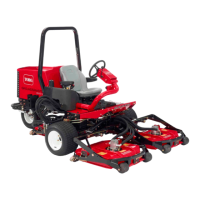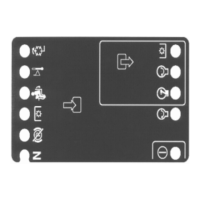21
Filling the Fuel Tank
Danger
Under certain conditions, diesel fuel and fuel
vapors are highly flammable and explosive. A fire
or explosion from fuel can burn you and others
and can cause property damage.
• Use a funnel and fill the fuel tank outdoors, in
an open area, when the engine is off and is cold.
Wipe up any fuel that spills.
• Do not fill the fuel tank completely full. Add fuel
to the fuel tank until the level is 1 in. (25 mm)
below the bottom of the filler neck. This empty
space in the tank allows the fuel to expand.
• Never smoke when handling fuel, and stay away
from an open flame or where fuel fumes may be
ignited by a spark.
• Store fuel in a clean, safety-approved container
and keep the cap in place.
1. Tip seat forward and prop it with the support rod so it
cannot fall accidentally. Using a clean rag, clean area
around fuel tank cap (Fig. 18).
2. Remove cap from the fuel tank and fill the 6-1/2 gallon
(25 l) tank to within 1 in. (25 mm) from the top with
diesel fuel. Install fuel tank cap tightly after filling tank.
1
Figure 18
1. Fuel tank cap
Check Cooling System
Clean debris off screen and radiator/oil cooler daily, more
often if conditions are extremely dusty and dirty.
The cooling system is filled with a 50 / 50 solution of water
and permanent ethylene glycol anti–freeze. Check level of
coolant in expansion tank at beginning of each day before
starting the engine. Capacity of cooling system is 6 quarts
(5.6 l).
• If engine has been running, pressurized hot
coolant can escape when radiator cap is
removed and cause burns.
Caution
1. Check level of coolant in expansion tank. Coolant level
should be between the marks on side of tank.
1
Figure 19
1. Expansion tank
2. If coolant level is low, remove expansion tank cap and
replenish the system. DO NOT OVERFILL.
3. Install expansion tank cap.
Checking the Hydraulic System
Oil
The hydraulic system is designed to operate on any
high–quality detergent oil having the American Petroleum
Institute—API—“service classification” SF/CC or CD. Oil
viscosity—weight—must be selected according to
anticipated ambient temperature. Temperature/viscosity
recommendations are:
Expected Ambient
Temperature
Recommended Viscosity
and Type
(Extreme) over 90° F SAE 30, Type SF/CC or CD
engine oil
(Normal) 40–100° F SAE 10W-30 or 10W-40,
Type SF/CC or CD engine oil
(Cool—Spring/Fall)
30–50° F
SAE 5W-30, Type SF/CC or
CD engine oil
(Winter) Below 30° F Type “F” or “FA” ATF
Automatic Transmission
Fluid

